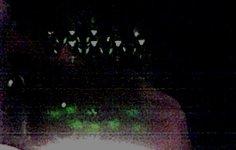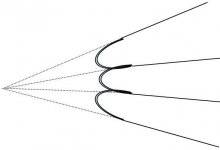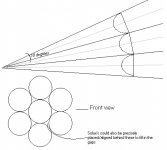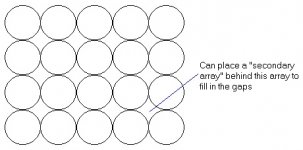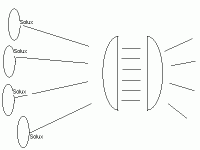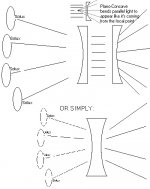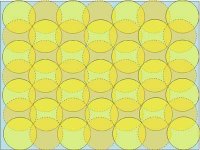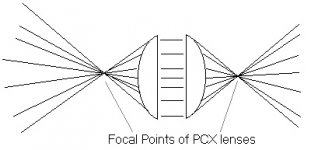yea, and not only is the filament on axis -- It's buried in the back of the bulb. There's probably an inch from the uv filter to the front of the bulb.
As I said, these things are awesome... So, If we can make the optics for multiple bulbs work out -- we're on to something.
BTW -- I wasn't kidding about the welding helmet it you are going to look at one of these things.... In fact I might try that infront of my digital camera to see if I can get some pics.
As I said, these things are awesome... So, If we can make the optics for multiple bulbs work out -- we're on to something.
BTW -- I wasn't kidding about the welding helmet it you are going to look at one of these things.... In fact I might try that infront of my digital camera to see if I can get some pics.
Ahh, the joys of owning a mig welder.... and holding up a #10 green filter in front of a 20 dollar digital camera....
If you look at the green spots, that is the solux beam @ 8"
The bulbs are not siliconed down and are not in any particular pattern, but are very close together.
I also misspoke, it's over 1/2" from the tip of the bulb to the uv glass, not 1"
If you look at the green spots, that is the solux beam @ 8"
The bulbs are not siliconed down and are not in any particular pattern, but are very close together.
I also misspoke, it's over 1/2" from the tip of the bulb to the uv glass, not 1"
Attachments
That's quite interesting, you'd have to block off any light comming directly from the bulb itself though. Sort of like a bouquet of solux's, ay? If only there was a way too fill in the gaps between the solux's with some kind of light.
Or maybe the manufacturer of solUx has some semi-rectangular reflectors tucked away somewhere.
I like that idea though, it's kinda sly.
Or maybe the manufacturer of solUx has some semi-rectangular reflectors tucked away somewhere.
I like that idea though, it's kinda sly.
the triangles are the back of the solux bulbs. There's a little bit of light leakage out the back of the bulb. I have a 3 sided box of 2x8's holding up the glass, and it's projecting down onto a plywood surface. The white is glare, either off my #10 green, or something. The point was that @8" away there is a very defined spot of light.
Remember, without the reflector, this is just a typical halogen. You can buy e11 base 120volt halogens up to 500 watt that will have the filament on axis with whatever reflector you come up with. (If you want to experiment, try car headlight reflectors.....)
Remember, without the reflector, this is just a typical halogen. You can buy e11 base 120volt halogens up to 500 watt that will have the filament on axis with whatever reflector you come up with. (If you want to experiment, try car headlight reflectors.....)
I'm going to send a reply to Solux on monday
So should I ask them if they have a 150,000 - 300,000 FC bulb with a 36 degree beam?
Does that sound like the right specs? Am I missing anything?
So should I ask them if they have a 150,000 - 300,000 FC bulb with a 36 degree beam?
Does that sound like the right specs? Am I missing anything?
I think 18Wheelers idea is worth looking into (pic below). Of course you'd have to be very careful to get all angles very precise and correct (Sorry JBELL, i know that drawing these things is a hell of alot easier than actually breaking out the ruler and glue and building them)....But i think the idea of making the Soluxs "act" like a point light source may be worth trying...
(Of course with this configuration, a bit of the bulb tips would have to be silver painted)
(Of course with this configuration, a bit of the bulb tips would have to be silver painted)
Attachments
These would enable us to still use the single fresnel instead of a double fresnel with a point source.
And that means we could place the solux array as close to the single fresnel as heat will allow.
And that means we could place the solux array as close to the single fresnel as heat will allow.
Good idea's guys, my current thoughts go like this.
Use a plano convex to coverge the light. The bulbs would be in an arc that follows the shape of the lense, so that the light that exits the plano side is still reasonable focused. Then use another plano convex to spread the light over the fresnel just behind the lcd.
Sound like it would approximate a point light source?
I'm really thinking that real world -- that focusing multiple bulbs into a single location (concave arc) would be much easier than trying to "fan out" the light by arranging the bulbs in a convex arc with additional lights behind to fill in the gaps.
Use a plano convex to coverge the light. The bulbs would be in an arc that follows the shape of the lense, so that the light that exits the plano side is still reasonable focused. Then use another plano convex to spread the light over the fresnel just behind the lcd.
Sound like it would approximate a point light source?
I'm really thinking that real world -- that focusing multiple bulbs into a single location (concave arc) would be much easier than trying to "fan out" the light by arranging the bulbs in a convex arc with additional lights behind to fill in the gaps.
Attachments
Ahhh...Actually thinking in reverse, the 1st lens would have to be a Plano-Concave also..... actually, instead of 2 lens....You may be able to do it with only 1 Concave-Concave....But i think you would still have the problem with the gaps in between solux's....So maybe a second array behind to fill in the gaps is inevitable.....But i think the second array (like the first array) would have to be precisely aligned so that it doesn't cross beams too much with other solux's
Attachments
But then again i think that optical lenses would be much less forgiving to light angles than fresnels...So that the solux's not being EXACTLY parallel beams might screw up the optics....In fact i think that sort of setup would need a long filament to copy the the shape of the concave curve rather than a bunch of bulbs....
I think it would work better with some sort of fluorescent or neon tube shaped to the curve of the concave so that it could match the direction the light would be travelling if it was going in the opposite direction. ANd even then the fluorescent source would probably be too diffuse....Maybe some sort of long filament bulb would be best for that...And in fact I think a concave-concave would be the best condensor lens for a long filament bulb.
I think it would work better with some sort of fluorescent or neon tube shaped to the curve of the concave so that it could match the direction the light would be travelling if it was going in the opposite direction. ANd even then the fluorescent source would probably be too diffuse....Maybe some sort of long filament bulb would be best for that...And in fact I think a concave-concave would be the best condensor lens for a long filament bulb.
Actually it would probably work with the 2 plano-concave lens system (above pic) if the Solux reflector was Elliptic and all them were focusing the light onto the focal point of the 1st plano-concave. But then you still have the gaps problem so again i think a second rear array may be inevitable.
no man you got it backwards
they would have to be plano-convex
if the list was coming from the other side (straight in), a plano-concave lens would converge the light. The same happens when you shine the light through the lens the other way, just backwards
Correct me if I'm forgetting something though...
they would have to be plano-convex
if the list was coming from the other side (straight in), a plano-concave lens would converge the light. The same happens when you shine the light through the lens the other way, just backwards
Correct me if I'm forgetting something though...
Property said:Actually...why not even do this since the solux beams are so straight--straighter than i think even JBELL suspected (pic below). These would enable us to still use the single fresnel instead of a double fresnel with a point source.
eh, you need 49 lamps to 'almost' cover a 15" monitor screen, if each one gives 2" diameter coverage:
Attachments
Psionic:
I believe i got it right...Check this out
How Lenses Work
18 Wheeler:
According to my picture Post #109 you'd need 32 of them (remember, a 15" LCD has actual dimensions something like 12"x9")...But Your right it's a bit excessive...So i think it would be better suited to a smaller LCD...But from recent Posts on the Forum it seems like we are getting closer and closer to finding small LCDs for cheap.
I believe i got it right...Check this out
How Lenses Work
18 Wheeler:
According to my picture Post #109 you'd need 32 of them (remember, a 15" LCD has actual dimensions something like 12"x9")...But Your right it's a bit excessive...So i think it would be better suited to a smaller LCD...But from recent Posts on the Forum it seems like we are getting closer and closer to finding small LCDs for cheap.
I guess the Plano-Convex Lenses would Work Also...But the diagram would be something like this (Which is why the Plano-Convex inverts the image ----Pretty cool how all that image gets focused into a single point (focal point) and comes out the other side intact eh? What does the stinking image do in that small point???)
I don't know which lens would be better to use (would have less distortion).
I don't know which lens would be better to use (would have less distortion).
Attachments
- Status
- Not open for further replies.
- Home
- General Interest
- Everything Else
- The Moving Image
- DIY Projectors
- solux -- the perfect light source?
